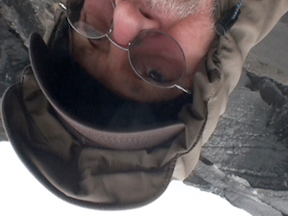The EAI Collection: Artist Index
Artist Index
Peter d'Agostino investigates the personal, cultural and technological systems of signs, language and communications that permeate everyday life. D'Agostino applies semiotic, deconstructive and appropriative strategies to his analyses and critiques of the structure, function and influence of broadcast television.
Jaime Davidovich was a conceptual, video and installation artist, as well as a pioneering activist for the potential of artist-run, local cable television programming. Davidovich was a founding member of Cable SoHo (1976) and president of the Artists' Television Network (1978). His own cable access show, a weekly variety program called The Live! Show, aired on Manhattan Cable Television from 1979 until 1984. In the guise of his alter-ego, Dr. Videovich, Davidovich hosted the show, which featured performances by and interviews with art world personalities, live phone-ins and a home-shopping segment from which he sold his collection of TV-related kitsch.
As an artist, theorist, critic, teacher, and writer, Douglas Davis played an active role in contemporary art across five decades. A pioneer of video in the 1970s, his "live" satellite performance/video pieces were seminal exercises in the use of interactive technology as a medium for art and communications. Davis was also an influential writer, authoring several books and serving as art and architecture critic for Newsweek magazine from 1969 to 1988.
Television, film and video editor Cara DeVito has produced numerous news features for broadcast, and received an Emmy Award for Outstanding Individual Craft in film editing.
In 1973, Dimitri Devyatkin became the first American to study at the U.S.S.R. State Institute of Cinematography in Moscow. Devyatkin's Russian heritage and his direct interaction with people in the former Soviet Union have been central to his work.
Video has been central to Cheryl Donegan's art since the early 1990s, when she burst onto the scene as part of a generation of artists, many of whom are women, developing a new conceptual art practice. Donegan's work integrates the time-based, gestural forms of performance and video with forms such as painting, drawing, and installation. Provocative and irreverent, her body-based, performative video works put a subversive spin on issues relating to sex, gender, art-making, art history, and pop culture.
One of video's most original voices, Juan Downey produced a major body of work that interweaves a sophisticated multicultural discourse with an idiosyncratic search for identity. Merging the subjective and the cultural, the diaristic and the documentative, Downey investigated the self through the historical texts of Western art and culture, and the rituals of his native Latin America. A native of Chile who came to New York in 1965, Downey died in 1993.
Since its inception in 1972, DCTV has been at the forefront of the independent social-issue documentary movement, and has contributed to several landmarks of that genre.
Cheryl Dunye emerged as part of the 1990's "queer new wave" of young film and video makers who dealt with gay and lesbian themes with a new directness and vitality. Dunye's work is defined by her distinctive narrative voice, a low-tech aesthetic, and an ironic blurring of fiction and "real life." Often set within a personal or domestic context, her stories foreground issues of race, sexuality and identity.
Jean Dupuy started his artistic career as a painter but shifted his practice when he moved from France to New York in 1967. Dupuy experimented with new technologies and was a prominent figure in the Art and Technology movement. In the early 1970s he started performing collectively with New York artists, and became known as an organizer of and participant in downtown performance events.

















